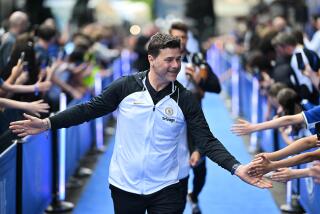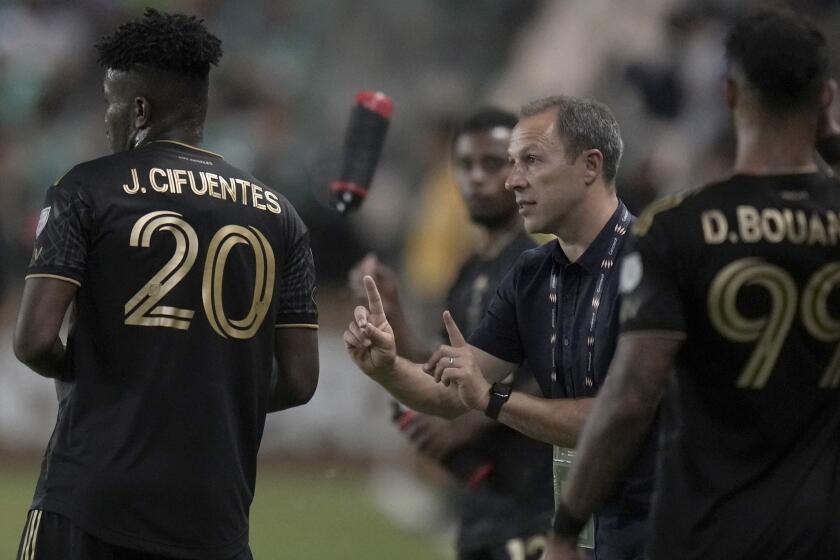COMMENTARY : There’ll Be No U.S. Miracles in World Cup Soccer Tourney
- Share via
TIRRENIA, Italy — Poor fellows. Because they are American soccer players, they are assumed to have been born to moon landings and Miracles on Ice and other unprecedented successes.
“Even some of my friends who don’t know much about soccer say, ‘You guys better bring home the Cup!’ ” said Paul Caligiuri, the midfielder whose goal against Trinidad and Tobago in November barely sneaked the Americans into the 24-nation final field of the World Cup Soccer Tournament.
They can’t win.
Literally and figuratively and every other-ly.
Poor lads. To have put themselves into this monthlong tournament, which will become a rare reality for the Americans when they play Czechoslovakia on Sunday, would be a blessing if it weren’t such a curse. It’s the most popular sporting event on Earth.
But these guys aren’t conditioned for soccer; their youth and inexperience make them like CBA basketball players compared to the NBA level of the World Cup. They’re conditioned only to “Go for the Gold”--and they don’t have a prayer.
The support system just isn’t there for them. There is no American professional soccer league because there is no public interest for such a league. U.S. network television ignored the most important game in the nation’s soccer history, that November World Cup qualifier against Trinidad and Tobago. And when U.S. cable-TV aired the game--on delayed tape, of course, though it was beamed live to much of Europe and South America--U.S. viewers virtually ignored it. It got a 0.8 rating on ESPN, compared to a 2.7 for an auto race and 7.3 for an NFL game the same date.
“Then we beat Trinidad and people said, ‘Who’s Trinidad?’ It’s the American mentality,” Caligiuri said. “They don’t realize that we (American soccer players) come from an underdeveloped situation.”
Their own federation reminded the U.S. players of their modest worth in January, when it offered roughly $40,000 apiece to sign on with the national team through the World Cup. Take it or leave it. Several of the veterans were outraged at first; four of them--Caligiuri, goalkeepers Tony Meola and David Vanole and midfielder John Harkes--tried holding out for more. But that didn’t work, because the federation didn’t have more. (Vanole never did sign; he gets $40-a-day meal money.)
Contrast that with Argentina’s Diego Maradona, who makes $3 million a year playing soccer and another $8 million a year just being a famous soccer player.
Peter Vermes, among the more worldly of the American players, knows what it’s like out there: Upon signing with a first-division professional club in The Netherlands, he began reading in the Dutch newspapers quotes from his teammates, asking: “Why did we sign him? What do we need an American for?”
These Americans are not in a class with the ice hockey Americans, who ranked in the lower half of the world top 10 when they played out their so-called Miracle on Ice in the 1980 Winter Olympics. These Americans are considered lucky to be among the World Cup’s final 24 because they qualified from the weak North-Central American-Caribbean zone, whose only power--Mexico--had been expelled from the qualifying tournament for using over-age players.
Really, how can one fairly expect much from this team? In Cup preparation matches this year, the Americans were 8-7-1 and lost only once in their last six games. But against other World Cup qualifiers, they were 0-4. What most of them want, from this grand championship stage, is to somehow make it to the second round and then go off, individually, to well-paying jobs playing soccer in Europe. Where somebody cares about them.
Poor fellows.






